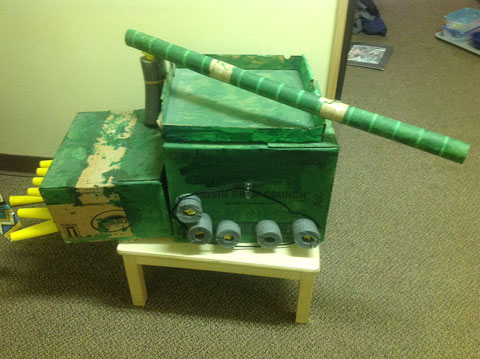
Angie Herrington
St. Ambrose University Children’s Campus
Davenport, Iowa
This project was undertaken in the Dragonfly classroom at the St. Ambrose University Children’s Campus in Davenport, Iowa. The Children’s Campus serves children ages 2 months to 5 years old. The Children’s Campus teachers begin exposing children to inquiry-based learning in the infant room. Consequently, many of the 3- to 5-year-old children in the Dragonfly class had lots of experience with project work prior to participating in their project on combines. Children in the Dragonfly room attend full days five days a week. The Dragonfly classroom has one lead teacher, an assistant teacher, and a student worker.
The Combine Project took place during Fall 2014. Sixteen children were involved in the project.
Phase 1. Beginning the Project
In Iowa in September, it is common to see farmers driving combines to harvest corn. One day one of the children in my class mentioned that he had seen a combine harvesting corn. The other children chimed in about their combine sightings. I recognized their shared interest and thought I would try and get a project on farm machinery started. By undertaking this project, the teachers hoped that the children would
- learn what a combine is used for,
- gain an appreciation for “grown” food, and
- learn the shapes and sizes related to a combine.
The following week I brought in toy tractors and combines. We read books about harvesting corn. We watched a video that demonstrates the real uses of combines and read the following books (all were donated by a parent who works at John Deere):
- Johnny Tractor Finds a Home
- Corny the Cornpicker
- Johnny Tractor and His Pals
The children did some memory drawings. Some children had prior knowledge and were able to draw a basic combine, while others shared verbal “sightings” of combines and required a teacher to help remember what it looked like:
- Max (3.8 years old): “I saw a combine on the way to school. It was combining.”
- Dylan (4.1 years old): “Farmers use combines. They drive them in the corn.”
The children’s interest and engagement in the topic kept growing. They were interested in using toy combines and setting up fields for the combine to work. A child said, “We could use cardboard to be the dirt in the field!” We used a piece of cardboard that we cut from a box, turned it to the corrugated side, and used it as the rows for the combine to work. I shared that my father writes books about how to fix combines, which interested the children in pretending to fix the combines.
Children were wondering how big a combine is, at which point they used tape measures in the classroom along with the Unifix Cubes to make predictions about how big the combine might be.
Almost daily, one of the children would comment about seeing a combine either that day, during the evening, or on a weekend. This became part of normal classroom conversation, which led to children asking each other what color it was, what it looked like, and how big it was.
At the end of the week I asked the children if there was anything else they wanted to find out. They came up with several questions. I asked them to make predictions about some of the questions.

For the Combine Project the class developed a questions/predictions/findings chart:
| Combine Questions | Predictions | Findings (added during Phase 2) |
|---|---|---|
| Why is there a fire extinguisher on the combine? (SP) | In case there’s a fire in the engine (SP) | Because something might ignite and need to be extinguished. The corn is very dry at harvest and could ignite, also. |
| Why are there different combines? (SP) | In case they have something in their way (SP) | There are different attachments because it is used to harvest corn and soybeans. |
| How do they get gas in the combine? (KA) | They go to the gas station (KA) | Usually there is a fuel tank at the farm. The combine holds enough gas to work all day. |
| What happens if the combine breaks down? (JF) | The mechanic fixes it (SP). The farmer fixes it (JF). | There is a toolbox on the combine so the farmer can fix it. |
| Do they ever run out of gas in the field? (KT) | I think a truck comes to the field and gives them gas (KT) | No, because the tank is big enough for the whole day. |
| Where do the tractors and combines park when they are done working? | They park in the field until farm season is over. They park in a shed over winter. |
Phase 2: Developing the Project
In October 2014, the children in the Dragonfly classroom took a field trip to the John Deere Pavilion in Moline, Illinois. The pavilion has many hands-on exhibits on tractors and other heavy machinery plus educational films. When the children walked in and saw the combine, their eyes widened with what appeared to be excitement. “It’s huge!” was a common comment.
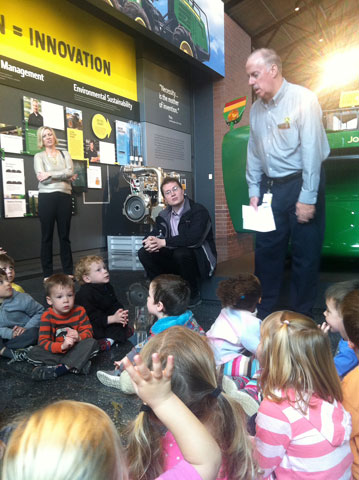
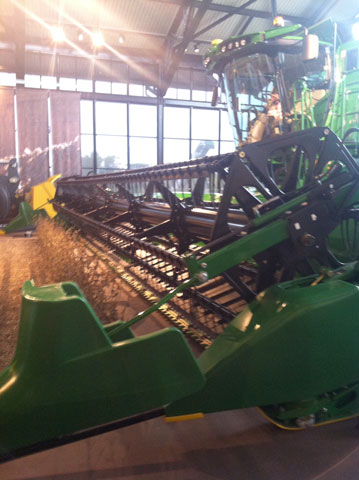
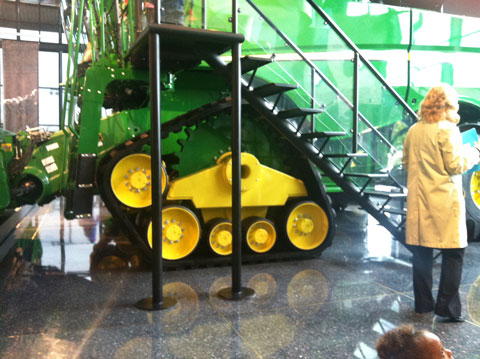
The children were allowed to touch and explore the combine, but the scale of the machine made it difficult to explore. The children were allowed to touch the actual combine on the outside as well as climb inside to explore the cab. They could pretend to drive the combine and see the chute up close. Some children chose to sketch the combine, while others simply explored it.
There also was a smaller combine at the field site, which we learned was used in rice fields in Asia. The children compared the smaller combine to the large one used in corn fields. Many children measured themselves inside the tires of the combine.
The children got all of their questions answered by the experts at the field site. The overwhelming size of the combine and the freedom to climb into it (as well as explore the other machines) encouraged the children to engage in self-exploration as a more interesting piece of the visit.
A Second Field Trip
Although the field trip to the John Deere Pavilion was good, I did not feel that the children really understood the connection between the giant machine (combine) and the corn.
A friend mentioned that the Family Museum in Bettendorf, Iowa, had a farm display that included a combine, so I contacted them to arrange a field trip. I had not been to that museum in quite a while, and I know that it is best practice to make a preliminary trip, so I asked if it would be OK for me to come do a preliminary walk through. They were very accommodating and did not charge for my visit!
The preliminary walk through was well worth the effort. I was able to try out the exhibits and think about questions I might ask children to help them notice aspects of the displays.
While I was there I discovered that the museum had a Tinker Lab where children could use tools to construct and invent. This was a wonderful discovery! I took advantage of the preliminary visit to chat with the gentleman in charge of the lab about the rules and expectations for visitors.
I used the information from my preliminary visit to prepare the children and the adults who planned to accompany us for the visit. I asked the children what they thought they might see in the farm display at the museum. They were very interested, and their predictions included a farm, corn, and a bulldozer.
I let the adults know that they would each be in charge of a small group of children and that they would be free to move about the museum. I shared aspects of the displays I wanted each child to have the opportunity to explore and asked them to debrief periodically about what they were experiencing.
During our field trip, the children had many experiences that helped them understand the field-to-table process. For example, they drove a scaled-down combine that had an interactive screen.
They picked plastic corn off stalks and turned a crank to send it up a conveyor belt into a grain bin. They canned corn on an assembly line and delivered the cans of corn to the grocery store where they could stock the shelves.
During the field trip to the Family Museum, we wanted the children to connect the steps involved in harvesting the corn using the combine, canning it, and then selling the cans of corn in the store. The Family Museum provided the children with hands-on exploration (riding in the combine, working the conveyer, and putting and selling cans of corn in the grocery store learning area).
The children visited the Tinker Lab in small groups with their accompanying adult. I had hoped they might decide to construct representations related to the farm or harvest, but they primarily explored what they could do with the tools and materials.
After a great visit to the Family Museum we loaded onto the bus and returned to our center. I asked the children to share what they learned from their trip to the museum. I was pleased that they were able to describe their experiences and relate them to the trip to the John Deere Pavilion.
A sampling of some of the children’s comments about their field trip to Family Museum:
- “The corn went up the red thing and then in the combine.” (Noah)
- “It looked like the other place we went to see a combine.” (Katie)
- “I’ve been there before, but I didn’t know that the corn would fill the cans and that when four cans were filled, one can would come out. Then we collected them and put them in the store.” (Keaton)
Building the Combine
The next day I asked the children what they wanted to make to show what they had learned. They all agreed that they wanted to make a combine. We had often used cardboard boxes to make group constructions, and perhaps because of that they immediately suggested that we make the combine out of boxes. The children encountered a problem. They wanted the combine to have a chute that would rotate like the chute on the real combine. I found a recycled piece of tubing from an old water heater box that I knew would work, but I did not explain how it might work. Instead I offered it to a small group of children, saying “What do you think about this piece? How could we make it turn? Do you think this might work?” Keaton solved the problem. He put the pieces together and attached the chute.
A grandmother donated some yellow spools that used to hold thread. I put those in the construction area and, as I predicted, the children decided to use them to create the corn picker head on the front. The children believed they were finished constructing the combine until they realized they didn’t have a place for the corn that was being picked. They decided to attach another box and painted it green.
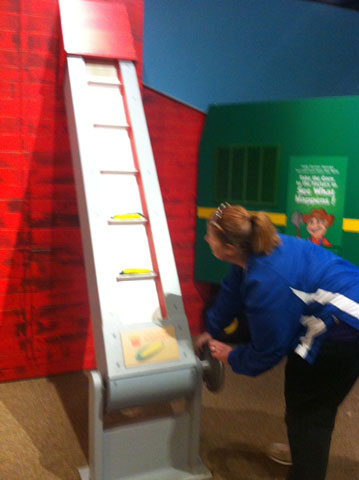
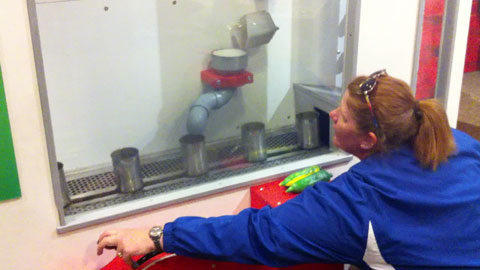

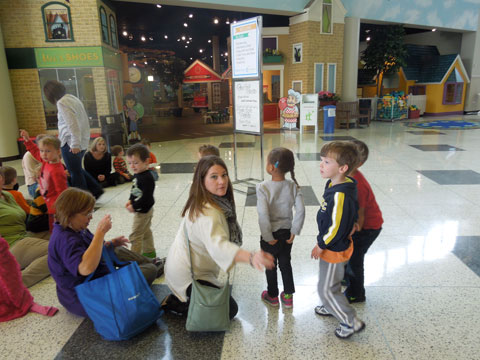
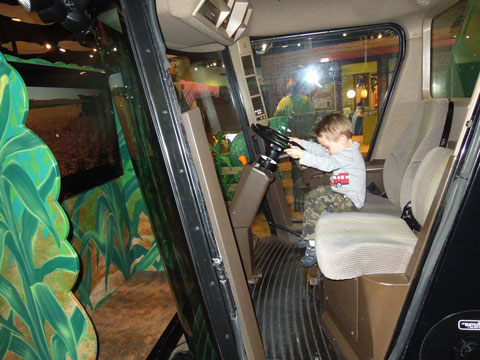
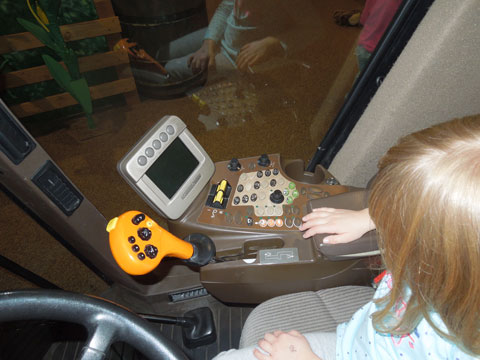
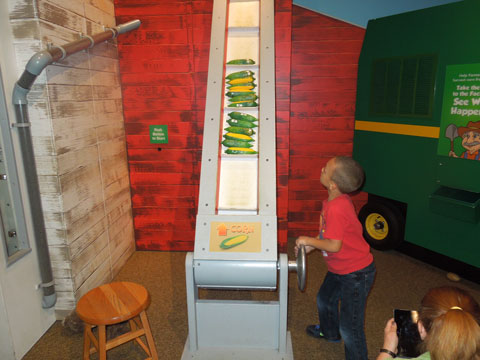
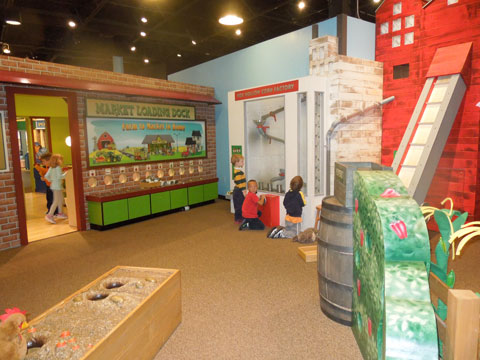
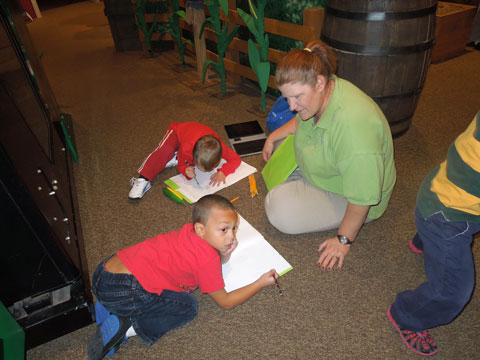
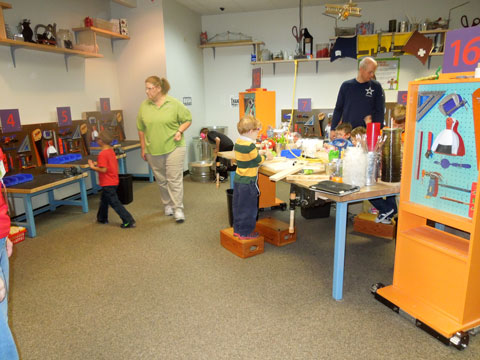
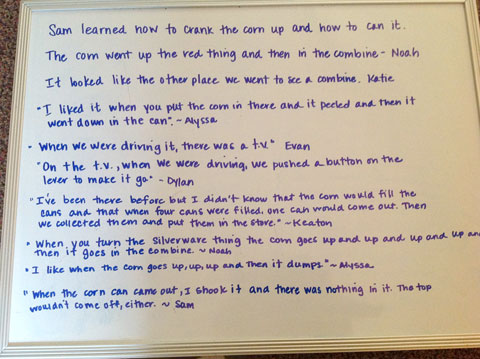

Completing the Question/Predictions/Findings Table
Children participated in building the combine in a variety of ways. All the children participated in some capacity. Some were only interested in painting the box while others were interested in making lists of materials that we needed. Children did not draw plans but rather used a photograph from our field site visit to guide them. The children and I referred to the question/prediction/answer table as we worked on building the combine as well as to enhance play. During the project we would return to the question/prediction table that we created during Phase I. As the children worked, they would ask a question or make a comment to which I or another child would say, “Let’s see what we found out.”
“We wondered. . .”
“and our prediction was. . .”
“but (findings) is what the answer was.”
Phase 3: Concluding the Project
Once the group construction of the combine was completed, the children seemed satisfied with their work and did not seem to want to carry the investigation further. Children became less interested in using the combine toys and were finished building the combine. It was time to have our culminating event.
Culminating Event
We asked the children whom they would like to share their new information with, and they chose to share it with the children in the classroom next door (the Leapfrog classroom). Children wrote invitations and delivered them to the teachers and children from the Leapfrog classroom. We invited them to come to our room so we could tell them about our Combine Project. We showed them our combine and our pictures and celebrated by eating cornbread muffins!
Teacher Reflection
As I reflect on the Combine Project, I think about two of the youngest children who had limited language skills but a very high interest in combines. The words and sentences that these two children began using during the project demonstrated that when interested, they were determined to use language. Both children were interested in the combine toys that were in the classroom as well, which not only encouraged them to use social language but at times required them to use social language to get a turn using the toy.
This project gave me a great opportunity to provide multiple sketching opportunities. Children began by drawing from memory what they thought a combine looked like followed by seeing the toy combines and drawing those. Going to the John Deere Pavilion to see a small combine and a full-size combine allowed children to sketch a real combine. Comparing the sketches allowed me to see the growth in the sketches. I shared the sketches with the children who sketched them, and as we talked, the children shared that they could see growth as well.
- Luke (4.9 years old): “I used to draw a combine like that. Now I draw it like this.”
- Sam (4.6 years old): “I can draw a better combine now!”
We conversed about how it takes practice and knowing more about a combine, and we talked about the word detail.
Throughout the project I altered my expectations to be congruent with the prior knowledge level of the children. Children who had not had exposure to tools were in need of that exposure, while other children had multiple experiences with tools. (We had done a tools project in the past and have a tool bench in our classroom.) The children who had prior knowledge with the tools were more ready to create a combine or a structure related to the combine than those who had little to no prior knowledge about using tools.
I had never considered going to the Family Museum as part of the project. However, when the opportunity was presented to me, I went to visit prior to the field trip. I was able to view the site and what it had to offer the children as well as speak to the staff to find out what was available to us for exploration. I took this information back to the classroom and asked the children to predict what they might see and what they might do while at the museum, which allowed me to get a feel for what they were highly interested in learning about.
Note: Deb Brownson, director of the St. Ambrose University Children’s Campus, contributed to this report on the Combine Project.


 Printer-friendly PDF
Printer-friendly PDF Printer-friendly PDF
Printer-friendly PDF